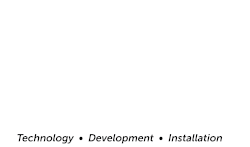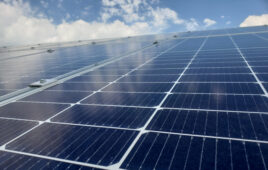Domestic solar tracker manufacturing is bound to increase thanks to the recently passed Inflation Reduction Act, which includes manufacturing tax credits for components found on solar trackers. The federal spending package will provide manufacturers with credits for torque tubes and structural fasteners produced on U.S. soil.
Credit: OMCO Solar/Aerial Agents
“I think the expectation is those manufacturer tax credits will trigger any tracker manufacturer that has offshored [production of] torque tubes or structural fasteners to onshore them,” said Ed McKiernan, president of Terrasmart, a turnkey manufacturer of solar racking, piles and electrical balance of systems. “As that happens, the end customers, the owner-operators of these arrays, they’re going to want to compete for lower prices. What you’re probably going to see is tracker prices becoming even more competitive, relative to fixed-tilt.”
The IRA specifically cites tracker systems and not fixed-tilt racking, as the former is the primary solar structure deployed on large- or utility-scale projects in the United States. Solar trackers produce more energy than a fixed-tilt system in a similar project footprint because the racking rotates and points modules toward the sun throughout the day.
Manufacturing production credits will provide $0.87/kg for torque tubes and $2.28/kg for structural fasteners. Both components are typically fabricated from steel.
“Given that there was industry input into the IRA for the manufacturing tax credit of trackers, how you measure that is probably the challenge,” said Gary Schuster, CEO of OMCO Solar, a domestic racking manufacturer. “Having said that, they concluded to measure that by pounds of torque tube that goes in a tracker, which is very logical, because it is a common denominator of manufacturing a tracker. I don’t know how else you would have done it.”

Credit: Terrasmart
Torque tubes are the rotating portion of a tracker that extends the entirety of the tracker row and hosts both panel rails and the panels themselves.
Structural fasteners have multiple purposes. According to the IRA, they connect torque tubes together, connect drive assemblies to torque tubes and connect mechanical and drive systems to solar tracker foundations. Schuster estimated that structural fasteners compose about 10 to 15% of a tracker’s total makeup.
While not included in the manufacturing production credits section of the IRA, ground-mounted fixed-tilt solar racking — and other solar hardware — is still incentivized through the investment tax credit (ITC) “domestic content bonus.” Solar arrays built with at least 40% of components that were manufactured in the United States can qualify for the domestic content bonus, which will boost a system’s tax credit an additional 10%. If projects meet other apprenticeship and prevailing wage requirements, system owners could receive a 40% tax credit on their array.
Manufacturers are emphasizing this option for fixed-tilt racking because it is primarily, if not entirely, made of steel. Steel fabrication is an active U.S. industry, and the domestic content credit just asks that steel-based components are manufactured in the United States, not including any metal additives in the refinement process.
“They’ve got to achieve a threshold for the entire project of domestic content, and, in many cases, they’re going to struggle to get there with modules and inverters,” McKiernan said. “Now, there are domestic alternatives there, but those are very limited and very oversold for the next several years. What we expect customers to do is really focus on mechanical and electrical balance of system so they can meet those domestic content requirements.”
At the time of publication, the Dept. of the Treasury is requesting input for implementing and delivering the clean energy tax incentives found in the IRA. Questions remain on the specifics of prevailing wage requirements, product qualifications for tax incentives and the overall timeline of the IRA.
“The biggest thing is not only the guidance on the domestic content definition, but then also the timing of the first projects,” said Eric Goodwin, director of business development at OMCO. “A lot of customers have questions on exactly when can I get this credit and put it forward? Will it be first quarter? Is it going to be Jan. 1? Is it going to be retroactive? We’re having customers ask for us to make that definition on the tracker components, but again, we really have to stand by and wait until that’s confirmed at the treasury level.”





This is where “policy” fails to define the “acceptability” of the very components aggregation that (will) allow an EPC developer to offer a conprehensive project that fills the customer requirements while also fulfilling the Governments edict as to what is exceptable to meet subsidy application to the project. It seems the way the current IRA is written, it may take from two to three years for more refining and foundry infrastructure within the U.S. borders to meet the requirement to drop tariffs on solar PV cells. It is still true to this day, depending on who’s statistics you use, China owns about 50% to 80% of silicon foundries and appurtenances that manufacture polysilicon and dope wafers to make solar PV cells that are sold World wide to solar PV panel manufacturers in other countries. The bottom line is this IRA “program” is more of a five year plan and if adhered to strictly will bring development of foundries and “in country” supply chains of materials to make solar PV panels in the U.S. from raw materials to end product without another country’s supply chain. Geopolitical interruptions in supply chains has been “spotlighted” since February of this year and the consequences can be dire in the long run.